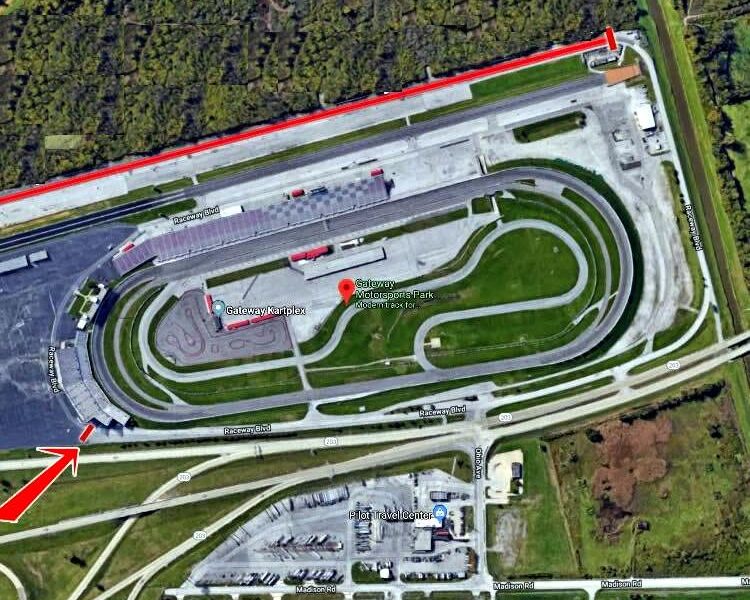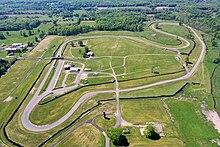In an era defined by rapid technological advancement and an insatiable thirst for innovation, the concept of a “World Wide Tech Raceway” emerges as a thrilling metaphor for the global race to dominate the technological landscape. Picture a vast track where countries, corporations, and creative minds are not only vying for supremacy but also collaborating in unprecedented ways, driving each other to new heights. This article delves into the intricate dynamics of this raceway, exploring the key players, transformative developments, and the implications of this technological sprint for our shared future. As we navigate the twists and turns of this high-speed journey, we will uncover how nations are harnessing their unique strengths, the role of emerging technologies, and the importance of sustainability in crafting a future where innovation knows no bounds. Welcome to the World Wide Tech Raceway—where the finish line is just the beginning of what’s possible.
Table of Contents
- Exploring the Global Landscape of Technological Innovation
- The Role of Emerging Markets in Shaping the Tech Race
- Key Strategies for Sustaining Competitive Advantage in Technology
- Fostering Collaboration and Ethical Practices in the Tech Ecosystem
- Q&A
- Final Thoughts
Exploring the Global Landscape of Technological Innovation
The competition in technological innovation today resembles a grand raceway, where nations and companies accelerate to gain the upper hand. Each contender has its unique approach, manifesting in vibrant ecosystems that foster creativity and ingenuity. The drivers in this race include:
- Startups leveraging cutting-edge technology to disrupt established industries.
- Research Institutions pushing the boundaries of science and engineering.
- Corporations investing billions in R&D to stay relevant in an ever-evolving market.
- Governments creating frameworks that encourage innovation through policy and funding.
As we navigate this dynamic landscape, it’s essential to understand the key players shaping the future:
| Country | Key Strengths |
|---|---|
| United States | Silicon Valley innovation, AI advancements |
| China | Manufacturing powerhouses, rapid digitalization |
| Germany | Engineering precision, automotive technology |
| Israel | Cybersecurity expertise, startup culture |
These nations not only compete but also influence one another, creating an intricate web of collaboration and rivalry that defines the global tech landscape. The race isn’t merely about speed; it’s also about sustainability, ethics, and the ability to pivot toward future demands. This interplay will determine the contours of technological advancement, so buckle up—the race is on!
The Role of Emerging Markets in Shaping the Tech Race
In the ever-evolving landscape of technology, emerging markets are not just passive spectators; they are vital players reshaping the competition. These regions, historically viewed as sources of low-cost labor, have transformed into innovation hubs that challenge traditional tech giants. The convergence of affordable talent, growing internet penetration, and increasing investment in tech infrastructure has fueled a wave of creativity. Cities like Bengaluru, Shenzhen, and São Paulo have evolved into epicenters of tech entrepreneurship, where startups innovate faster than the speed of regulation. This dynamic fosters a fertile ground for cutting-edge developments and creates a unique synergy between local needs and technological advancements.
The interplay between developed and emerging economies has led to a more democratized technological ecosystem. As emerging markets adopt and adapt new technologies, they drive cost-effective solutions tailored to local challenges, allowing for a more inclusive global tech landscape. Notable contributions include:
- Mobile payment systems revolutionizing commerce in African countries, enhancing financial inclusion.
- Telehealth innovations from India addressing healthcare access disparities.
- Green tech solutions in Brazil aiming to combat environmental issues while promoting sustainable growth.
This collaborative spirit not only boosts economic growth in these regions but also places them at the forefront of global tech trends, ensuring that the race for technological supremacy includes diverse voices and perspectives.
Key Strategies for Sustaining Competitive Advantage in Technology
In the relentless race of technology, businesses must harness innovation and adaptability to maintain their lead. One crucial approach is embracing a culture of continuous learning within the organization. By encouraging employees to pursue ongoing education and training, a company can stay at the forefront of emerging trends and technologies. This not only enhances the team’s skill sets but also stimulates creative thinking, leading to innovative solutions that differentiate the company in the market. Furthermore, investing in strategic partnerships can enable organizations to leverage shared resources and expertise, fostering joint development initiatives that propel both parties forward.
Another essential strategy is to implement a robust feedback mechanism to understand customer needs and preferences. Companies should continuously gather data through various channels, such as surveys, social media engagement, and customer reviews. By analyzing this data, businesses can iterate on their offerings, ensuring that products and services align with market demands. Additionally, adopting an agile approach allows companies to respond swiftly to changes, enabling them to pivot resources effectively and keep pace with technological advancements. This dynamic flexibility is paramount in a world where yesterday’s innovations can quickly become obsolete.
Fostering Collaboration and Ethical Practices in the Tech Ecosystem
In a world where innovation meets competition, it is imperative that tech companies and stakeholders unite to foster an environment of collaboration and ethical practices. A shared vision among industry players can lead to groundbreaking solutions and enhanced user experiences. Companies can achieve this by embracing transparency and accountability, creating guidelines that encourage responsible technology development. By prioritizing the following key principles, organizations can strengthen their commitment to ethical practices:
- Open Communication: Encourage dialogue among teams, users, and stakeholders.
- Diversity and Inclusion: Ensure diverse perspectives guide technological advancements.
- Ethical Standards: Develop and adhere to stringent ethical guidelines.
- Collaborative Initiatives: Launch joint projects that benefit the community and industry.
Building a sturdy foundation for collaboration also requires acknowledging the common challenges faced within the tech ecosystem. To tackle these effectively, organizations can utilize strategic frameworks and establish partnerships that highlight shared values. The table below outlines some challenges alongside potential collaborative solutions:
| Challenge | Collaborative Solution |
|---|---|
| Data Privacy Concerns | Create industry-wide data protection standards. |
| Skills Gap | Launch mentorship and training programs across companies. |
| Environmental Impact | Develop joint sustainability initiatives and share best practices. |
Q&A
Q&A: Unraveling the World Wide Tech Raceway
Q1: What is the World Wide Tech Raceway?
A1: The World Wide Tech Raceway is an expansive motorsport facility located in Madison, Illinois, just across the Mississippi River from St. Louis, Missouri. Established in 1967 and originally known as Gateway International Raceway, the venue has transformed into a hub for various motorsport events, including NASCAR races, NHRA drag racing, and off-road competitions, making it a prime destination for racing enthusiasts globally.
Q2: What sets the World Wide Tech Raceway apart from other racetracks?
A2: One of the standout features of the World Wide Tech Raceway is its unique configuration, which includes a one-and-a-quarter-mile oval track alongside a multi-purpose road course and a professional drag strip. This versatility allows it to host a diverse array of racing events, appealing to different fan bases and driving styles. Additionally, the track’s proximity to a major metropolitan area like St. Louis enhances its accessibility to spectators and participants alike.
Q3: How does the venue contribute to the local economy?
A3: The World Wide Tech Raceway significantly impacts the local economy by attracting thousands of visitors during race weekends and special events. This influx boosts local businesses such as hotels, restaurants, and retail shops. Moreover, the facility creates jobs not only in racing-related capacities but also in hospitality and event management, making it a vital entity for community growth and employment opportunities.
Q4: What are some of the key events hosted at the World Wide Tech Raceway?
A4: The Raceway is known for hosting several high-profile events, including the NASCAR Camping World Truck Series, various NHRA events such as the Dragmeter Classic, and numerous local racing series that showcase emerging talent. Additionally, the venue often serves as a site for automotive shows and community events, further cementing its status as a multifaceted entertainment destination.
Q5: How has technology influenced the racing experience at the facility?
A5: Technology plays a crucial role in enhancing both the racing experience and spectator engagement at the World Wide Tech Raceway. Advanced timing systems and data analytics allow teams to optimize performance, while high-definition video screens and mobile applications keep fans connected and informed. Additionally, improvements in safety technology ensure that both drivers and spectators enjoy the races with enhanced levels of security.
Q6: What are the future plans for the World Wide Tech Raceway?
A6: The World Wide Tech Raceway is continuously evolving and adapting to the ever-changing world of motorsports. Future plans include facility upgrades to enhance fan experiences, increased sustainability initiatives focusing on eco-friendly practices, and the potential introduction of new racing series to attract broader audiences. These initiatives aim to solidify the Raceway’s place as a premier motorsport destination in the nation.
Q7: How can fans get involved with the World Wide Tech Raceway?
A7: Fans interested in getting involved with the World Wide Tech Raceway can purchase tickets to upcoming events, participate in fan engagement activities, or join the Raceway’s membership program for exclusive benefits. Additionally, volunteering opportunities during race days allow enthusiasts to get an inside look at the racing world, making it an exciting way to experience the thrills of motorsports firsthand.
In a world where technology and tradition collide, the World Wide Tech Raceway stands as a testament to the enduring love of speed and competition, continuously driving forward into the heart of motorsport enthusiasm.
Final Thoughts
As we cross the finish line in our exploration of the World Wide Tech Raceway, it’s clear that this dynamic venue is more than just a track; it embodies the convergence of speed, innovation, and community spirit. From its rich history rooted in motorsports to its forward-looking initiatives in technology and sustainability, the Raceway stands as a testament to the evolving landscape of racing. Whether you’re a seasoned enthusiast or a curious newcomer, this arena invites everyone to witness the thrilling tapestry of competition and camaraderie that makes motorsports a global phenomenon. As we gear up for what lies ahead, there’s no doubt that the World Wide Tech Raceway will continue to accelerate into the future, racing towards new milestones and unforgettable experiences. Keep your engines running, and see you at the next lap!



